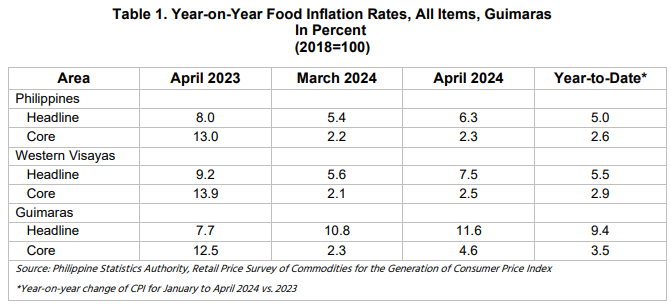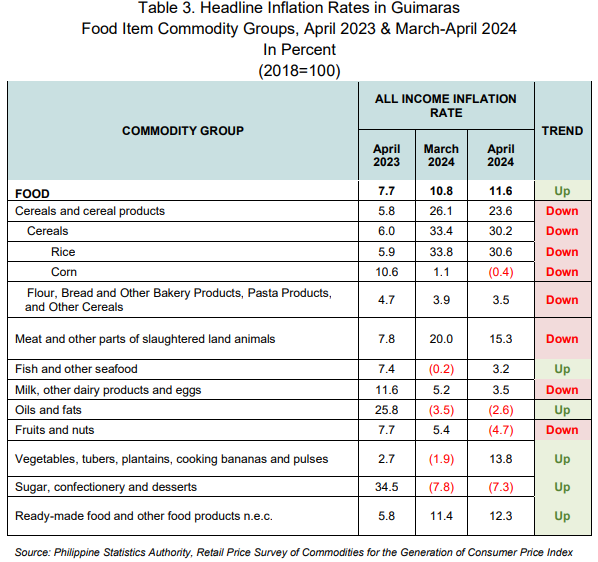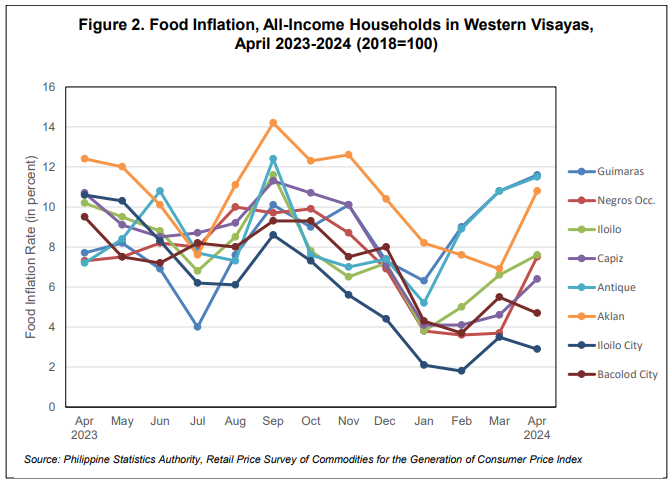

1. Guimaras Headline Food Inflation
The Guimaras’ headline food inflation expanded to 11.6 percent in April 2024 from 10.8 percent in the previous month, the highest food inflation recorded in thirteen months. In April 2023, food inflation was lower at 7.7 percent. (Figure 1, and Table 1)
1.1 Main Drivers to the Uptrend Trend of the Headline Food Inflation
The acceleration of food inflation in April 2024 was primarily influenced by the annual increase in Vegetables, tubers, plantains, cooking bananas and pulses at 13.8 percent during the month, from 2.7 percent in April 2023, with 58.2 percent share to the overall food inflation.
Also sharing to the uptrend of food inflation were fast increases observed in Fish and other seafood at 3.2 percent from -0.2 percent in March 2024 with 39.1 percent share to April 2024 food inflation, and Ready-made food and other food products n.e.c. at 12.3 percent from 11.4 percent in the previous month with 1.6 percent share.
Moreover, inflation rates were faster during the month in the indices of the following food items: Sugar, confectionery, and desserts, -7.3 percent from -7.8 percent; and Oils and fats, -2.6 percent from -3.5 percent.
In contrast, the following commodity groups registered slower inflation rates during the month:
a. Cereals and cereal products at 23.6 percent from 26.1 percent; b. Meat and other parts of slaughtered land animals at 15.3 percent from 20.0 percent in the previous month; c. Milk, other dairy products and eggs at 3.5 percent from 5.2 percent; and d. Fruits and nuts with a recorded inflation of -43.7 percent from 5.4 percent in March 2024.
a. Cereals and cereal products at 23.6 percent from 26.1 percent;
b. Meat and other parts of slaughtered land animals at 15.3 percent from 20.0 percent in the previous month;
c. Milk, other dairy products and eggs at 3.5 percent from 5.2 percent; and
d. Fruits and nuts with a recorded inflation of -43.7 percent from 5.4 percent in March 2024.

1.2 Main Contributors to the Headline Inflation
The top three commodity groups contributing to the April 2024 overall inflation were the following:
a. Cereals and cereal products, with 69.4 percent contribution or 8.05 percentage points;
b. Meat and other parts of slaughtered land animals with 15.4 percent contribution or 1.79 percentage points; and
c. Vegetables, tubers, plantains, cooking bananas and pulses with 7.6 percent contribution or 0.88 percentage points.

2. Headline Food Inflation per provinces in Region VI
In April 2024, Guimaras posted the highest headline food inflation among the six provinces and Highly Urbanized Cities (HUCs) in Western Visayas (WV) with 11.6 percent, followed closely by Antique with 11.5 percent. Aklan came in next with a food inflation rate of 10.8 percent; Iloilo City (7.6%); Negros Occidental (7.5%); Capiz (6.4%).
Iloilo City and Bacolod City reported the lowest food inflation in WV, recording a 2.9 percent and 4.7 percent, respectively, trailed by Negros Occidental and Aklan with 4.4 and 4.9 percent, respectively.
In terms of food inflation trend from March to April 2024, the province with the highest inflation increment was Aklan with 3.9 percentage points growth from 6.9 percent to 10.8 percent, followed closely by Negros Occidental with 3.8 percentage points growth from 3.7 percent to 7.5 percent.
In terms of inflation trend from March to April 2024, the province with highest inflation increment was Negros Occidental with 2.10 percentage points growth from 2.3 to 4.4 inflation, followed by Aklan and Capiz with a lump of 1.10 percentage points each from 3.8 to 4.9 inflation, and from 2.8 and 3.9inflation, correspondingly.
Meanwhile, from January 2024 to April 2024, all provinces posted an upward trend, while the two HUCs showed an erratic movement.

DEFINITION OF TERM
Inflation Rate
Rate of change in the Consumer Price Index. Its formula is given by:
Where: 𝐶𝑃𝐼2 is the current period
𝐶𝑃𝐼1 is the CPI in the previous period
Year-on-year inflation
Rate of change in the Consumer Price Index in a specific period of the current year relative to the same period in the previous year.
Month-on-Month inflation
Rate of change in the Consumer Price Index in a specific period of the current month relative to the previous month in the current year.
Consumer Price Index
Indicator of the change in the average prices of a fixed basket of goods and services commonly purchased by an average Filipino household for their day-to-day consumption relative to a base year. It is most widely used in the calculation of the inflation rate and purchasing power of the peso (PPP).
Relative to this, daily, weekly, and bi-monthly price surveys are conducted nationwide at the provincial offices including the District Offices of the National Capital Region (NCR) to be able to generate monthly CPI for All Income Households and CPI for the Bottom 30% Income Households. Indicators produced from price surveys are regarded as designated statistics.
The seasonally adjusted CPI provides comparisons after removing the seasonal variations that may affect the series. The formula used in computing the CPI is the weighted arithmetic mean of price relatives, the Laspeyre’s formula with a fixed base year period (2018) weights given by.
Purchasing Power of Peso (PPP)
Indicates how much the Philippine Peso is worth in each period relative to its value in a base period. It is computed by getting the reciprocal of the CPI and multiplying the result by 100 given by the equation:
Headline Inflation
Defined as the rate of change in the weighted average prices of all goods and services in the CPI basket while Core Inflation refers to the rate of change in the CPI which excludes the following item/commodity groups: rice, corn, fruits and vegetables, and fuel items.

